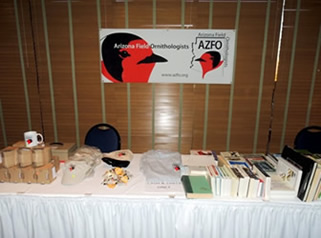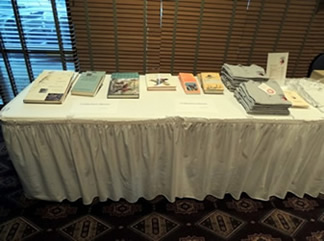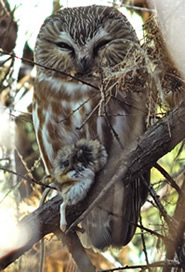Arizona Field Ornithologists
Sixth Annual State Meeting Summary
For Field Mini-Expedition Highlights click here
Text by Doug Jenness
Photos by Lauren Harter, Doug Jenness, and Bob Witzeman
The life and legacy of Gale Monson, the "father" of Arizona field ornithology, was the dominant theme of the AZFO's sixth annual state meeting in Lake Havasu City, 26-28 October 2012. From the opening remarks by AZFO president Troy Corman on Saturday morning to the closing of the Saturday evening program by Ken Rosenberg, more than 90 participants heard a dozen presentations, many that paid tribute to Monson.
The meeting opened with talks by recipients of AZFO Gale Monson Research Grants. The two 2011 grant recipients, University of Arizona graduate students Kristen Dillon and Carl Lundblad, spoke about their research on Red-faced Warblers and Yellow-eyed Juncos, respectively. Next, this year's grant recipients, John Arnett of Luke Air Force Base and Michael Lester of University of Arizona, briefly described their planned projects on Gray Vireos and Song Sparrows, respectively.
The meeting’s morning session focused on research and monitoring of birds in the lower Colorado River valley, an area where Monson conducted many field studies. Chris Dodge and Dawn Fletcher presented results of bird community monitoring projects along the river. Anne McLeod reviewed the expansion of the introduced tamarisk beetles and their known and potential effects on Southwestern Willow Flycatchers. Finally, Shannon McNeil described encouraging results of monitoring Yellow-billed Cuckoos at restored riparian habitats.
 Most of the afternoon session was devoted to several presentations directly related to Monson's contributions to field ornithology. Gary Rosenberg, secretary of the Arizona Bird Committee since 1996, related Monson's role in helping to establish the ABC in 1972 and in preparing, along with Allan Phillips, the Annotated Checklist of the Birds of Arizona in 1981. Describing her personal experience working with Monson, Janet Witzeman recounted his insistence on detailed documentation for all unusual sightings. She noted the importance of several books that he collaborated on or to which he contributed essays. She also read a message from Arnold Moorhouse, who collaborated with Monson on The Birds of Sonora. David Griffin came from Las Cruces, New Mexico to talk about his experience as a young researcher working at Cabeza Prieta National Wildlife Refuge, an area that Monson described in a chapter in The Birdwatcher's America, and how he and Gale became friends. Monson's abundant and detailed journals, begun when he was a boy, Richard Glinski explained, included notes of birds and other animals as well as plants. Glinski underlined Monson's capacity to reach out to and mentor young biologists as well as adapt to changes in field work that occurred in his lifetime. He urged participants at the meeting to follow Monson's example and extend a helping hand to budding field ornithologists and naturalists.
Most of the afternoon session was devoted to several presentations directly related to Monson's contributions to field ornithology. Gary Rosenberg, secretary of the Arizona Bird Committee since 1996, related Monson's role in helping to establish the ABC in 1972 and in preparing, along with Allan Phillips, the Annotated Checklist of the Birds of Arizona in 1981. Describing her personal experience working with Monson, Janet Witzeman recounted his insistence on detailed documentation for all unusual sightings. She noted the importance of several books that he collaborated on or to which he contributed essays. She also read a message from Arnold Moorhouse, who collaborated with Monson on The Birds of Sonora. David Griffin came from Las Cruces, New Mexico to talk about his experience as a young researcher working at Cabeza Prieta National Wildlife Refuge, an area that Monson described in a chapter in The Birdwatcher's America, and how he and Gale became friends. Monson's abundant and detailed journals, begun when he was a boy, Richard Glinski explained, included notes of birds and other animals as well as plants. Glinski underlined Monson's capacity to reach out to and mentor young biologists as well as adapt to changes in field work that occurred in his lifetime. He urged participants at the meeting to follow Monson's example and extend a helping hand to budding field ornithologists and naturalists.
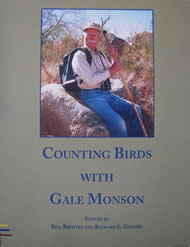 Janet Witzeman opened the program at the Saturday night dinner by introducing Monson's daughters who were present--Ruth Monson Bear, Anne Monson, and Rosemary Monson Remacle. She thanked them for their generous contributions to the AZFO research grants honoring their father, particularly for donating all the copies of the newly published CountingBirds with Gale Monson, edited by Glinski and Bill Broyles, to the AZFO
Janet Witzeman opened the program at the Saturday night dinner by introducing Monson's daughters who were present--Ruth Monson Bear, Anne Monson, and Rosemary Monson Remacle. She thanked them for their generous contributions to the AZFO research grants honoring their father, particularly for donating all the copies of the newly published CountingBirds with Gale Monson, edited by Glinski and Bill Broyles, to the AZFO 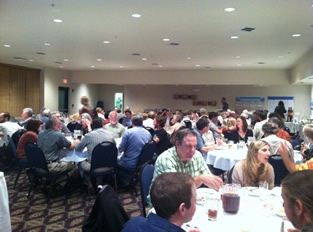 forthe grants. Thirty-seven copies ofthe book were sold atthe meeting raising $1,100 for the grants. The keynote speaker, Ken Rosenberg, from the Cornell Laboratory of Ornithology and coauthor of Birds of the Lower Colorado River Valley, described changes in birdlife on the lower Colorado River over the past 50 years. He noted that the field work that he and others did in that area in the 1970s and '80s was built on the previous studies by Monson and was pleased that there are now young researchers continuing to conduct field surveys and habitat restoration along the river.
forthe grants. Thirty-seven copies ofthe book were sold atthe meeting raising $1,100 for the grants. The keynote speaker, Ken Rosenberg, from the Cornell Laboratory of Ornithology and coauthor of Birds of the Lower Colorado River Valley, described changes in birdlife on the lower Colorado River over the past 50 years. He noted that the field work that he and others did in that area in the 1970s and '80s was built on the previous studies by Monson and was pleased that there are now young researchers continuing to conduct field surveys and habitat restoration along the river.
 In addition to the Saturday talks, participants recessed to view and ask questions about three poster presentations on Tree Swallow migration alongthe lower Colorado River, wintering Gray Vireos, and the relatively recent influx of Crested Caracaras into Pinal County. Reports and updates were also presented on field expeditions and finances. Officers and Board of Directors for the next year were elected: Troy Corman, President; Marceline VandeWater, Vice President; Doug Jenness, Treasurer; Steve Ganley, Membership Secretary; Erika Wilson, Recording Secretary, and three members at large, John Arnett, Lauren Harter, and John Yerger.
In addition to the Saturday talks, participants recessed to view and ask questions about three poster presentations on Tree Swallow migration alongthe lower Colorado River, wintering Gray Vireos, and the relatively recent influx of Crested Caracaras into Pinal County. Reports and updates were also presented on field expeditions and finances. Officers and Board of Directors for the next year were elected: Troy Corman, President; Marceline VandeWater, Vice President; Doug Jenness, Treasurer; Steve Ganley, Membership Secretary; Erika Wilson, Recording Secretary, and three members at large, John Arnett, Lauren Harter, and John Yerger.
Popular as usual, the used book and sale of polo shirts, caps, and mugs did a brisk business, exceeding any previous year. Participants enjoyed the bird photo and audio ID contests. The books provided by the Tucson Audubon Society bookstore and the Arizona Game and Fish Department were highly appreciated. These were used as prizes for winners of our raffle and bird photo and audio ID contests.
AZFO thank all that were involved in helping make this a very successful and memorable event. Special thanks go to DeeDee DeLorenzo and Lauren Harter for making all the arrangements in Lake Havasu City and organizing the successful mini-field expeditions, to John Arnett for moderating the meeting, and to Janet Witzeman for organizing the Saturday evening program.
The next annual meeting will be in Sierra Vista in October 2013.
SIXTH ANNUAL MEETING: Field Mini-Expedition Highlights
On Friday, October 26, and Sunday, October 28, AZFO meeting attendees participated in six field mini-expeditions to cover several under-birded areas in the vicinity of Lake Havasu City, AZ. Despite uncooperative weather on Friday, nearly every group discovered unusual species and documented several irruptive species such as Red-breasted Nuthatch, Evening Grosbeak, and Red Crossbill. Altogether, participants on the six field mini-expeditions found a total of 138 species. Read more about each mini-expedition below.
Friday, October 26, Afternoon Mini-Expeditions
‘Ahakhav Tribal Preserve
By Lauren Harter
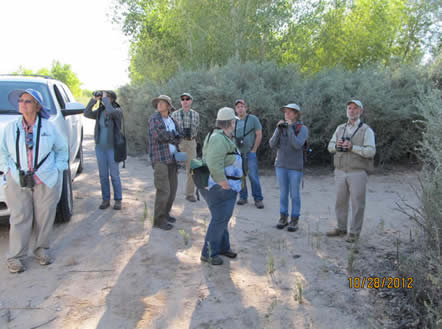 |
Eager to Begin! - Photo/DeeDee DeLorezo |
‘Ahakhav Tribal Preserve is known for its rarities, but birders usually only scratch the surface of this 1200-acre preserve. The preserve is one of the restoration areas designed to bring some riparian habitat back to the lower Colorado River Valley (LCRV). It was created by the Colorado River Indian Tribes and is supported by the Bureau of Reclamation. Currently the preserve consists of a small park with large, mature trees and four large restoration areas of planted cottonwoods, willows, and mesquites. The park area receives attention from birders, as migrants tend to concentrate in the large cottonwoods and dense mesquites. The restoration plantings can harbor many more birds but these are often more difficult to find in “the forest”. With fair weather and ample participants (about 30!), the AZFO Mini-Expedition split into four groups to cover each planting area to get an idea of bird use in late fall.
After about two hours of birding in the restoration planting, the teams tallied a total of 40 species. The consensus was that flocks of migrants and winter residents tended to concentrate at edges where mesquites and cottonwoods or willows meet. The greatest number of birds was found in plots dominated by mesquite. The highest diversity was found in plots on the west side of the preserve, where a mixture of open areas, denser stands, and mesquite and willow thickets abut an agricultural area. The most common species was Yellow-rumped Warbler. Other common migrants/winter residents were White-crowned Sparrow, Ruby-crowned Kinglet, Northern Flicker, and Dark-eyed Junco. Several irruptive species were present, including three Red-breasted Nuthatches, six Golden-crowned Kinglets, an American Robin, a “Gray-headed” Junco, and a flyover Pine Siskin. Three Black-throated Gray Warblers and a “Western” Flycatcher were also notable, but the highlight of the afternoon was a WHITE-THROATED SPARROW. A flyover flicker with yellow flight feathers was tantalizing, but observers weren’t able to confirm whether it was a “Yellow-shafted” Northern Flicker or a Gilded Flicker.
On the way to Lake Havasu City after the expedition, many participants made a brief stop at Parker Dam, where a BLACK SCOTER had been discovered earlier that day. The scoter was first spotted below the dam on the California side, but obligingly swam across the river into Arizona waters. The day ended in the dim evening light, with Double-crested Cormorants swooping below Parker Dam to precariously roost on a power line over the river.
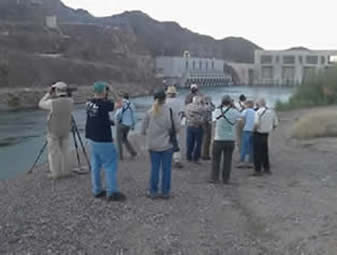 |
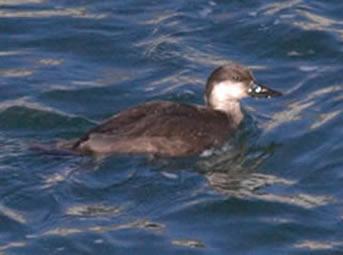 |
Viewing Black Scoter at Parker Dam! – Photo/Troy Corman |
Black Scoter – Photo/David Vander Plyum |
Lake Havasu City
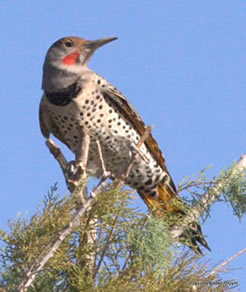 |
Gilded Flicker – Photo/David Vander Pluym |
By David Vander Pluym
Strong winds prevented the three “pelagic” boats from going out onto Lake Havasu. A quick look at the white caps on the lake and the group was happy to stay on land! The 20 participants who decided to go with the contingency plan split into two groups, and David Vander Pluym and John Yerger led them to several local birding hotspots to scan the lake.
Both groups started at Rotary Park where, despite the high winds, we saw a few passerines including two Red-breasted Nuthatches, members of this fall's continent-wide invasion. Among the beach-dwelling gull flocks we studied three species, including a Herring Gull and several California Gulls. David’s group also studied the local Mallard flock and enjoyed a review of last year’s talk on Mexican Ducks while viewing several likely intergrades. John’s group also enjoyed a Peregrine Falcon, a Horned Grebe, and a locally rare Inca Dove. The two groups saw a total of 34 species in this small city park.
Despite difficulty scoping in the wind, a trip to the north end of Lake Havasu was productive. Combined, the 2 groups found 37 species at this area, including multiple Horned Grebes, a Herring Gull, early Canvasbacks, and notable landbirds. Several in David’s group saw a Gilded Flicker, a steadily declining species in the LCRV. Likely functionally extinct as a breeder along the main stem of the Colorado River, Gilded Flicker is now mostly a very rare late fall and winter visitor to this area.
Sunday, October 28, Mini-Expeditions
Havasu National Wildlife Refuge, Behind Closed Gates
By DeeDee DeLorenzo
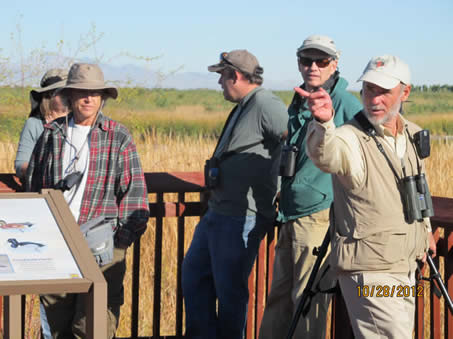 |
Beal Lake – Photo/DeeDee DeLorenzo |
The AZFO field mini-expedition, Havasu NWR, Behind Closed Gates, began on Levee Rd., the westernmost side of Havasu NWR. As we headed south we stopped to look at two raptors, which were identified as a Red-tailed Hawk and a Northern Harrier. As the harrier left its snag and headed for the river, a flock of approximately 110 Snow Geese flew north over Topock Marsh, probably headed for the farm fields in southern Mohave Valley. We did not spend much time on Levee Rd., but other species found along the way included Anna’s Hummingbird, Phainopepla, Yellow-rumped Warbler, Abert’s Towhee, and Song Sparrow.
Our first major stop was Beal Lake located near the west end of Old South Dike, and as was to be expected this site certainly did not disappoint us. As we set up our scopes on the observation deck a flock of Northern Shovelers flew in and joined the array of waterfowl and shorebirds. Killdeer, Greater Yellowlegs, and Great-tailed Grackles were vocal throughout the morning, and when a harrier glided just above the water, Least Sandpipers, Dunlin, and Long-billed Dowitchers could be heard as they quickly lifted off the sandbars and zoomed around the lake only to settle down within a few minutes. A lone White-faced Ibis probed the edges and Snowy Egrets searched for small invertebrates among the emergent vegetation. Great Egrets crossed the lake, Double-crested Cormorants perched on snags that jutted from the water, and American White Pelicans quietly rested on a sandbar. From one side of the lake to the other small numbers of Northern Pintail and Green-winged Teal could be seen, and a single Bufflehead was diving in the shallow waters. Black and Say’s Phoebes darted to and from their perches as Song Sparrows and Marsh Wrens flew in and out of the reeds lining the marsh. Yellow-rumped Warblers, Black-tailed Gnatcatchers, Verdins, a Ruby-crowned Kinglet, and a White-crowned Sparrow flitted in the mesquite and tamarisk behind us, and Northern Flickers and Ladder-backed Woodpeckers could be heard in the distance. A few Wilson’s Snipes and American Pipits were finally located, and a Sharp-shinned Hawk passed by quickly. Pied-billed Grebes, Eared Grebes, and Ring-billed Gulls were present, and a Belted Kingfisher eventually flew in landing on a post sticking out of the water. After one more scoping around the lake we moved to the Beal Restoration Site.
Chris Dodge (Bureau of Reclamation and the Lower Colorado River Multi-Species Conservation Program) was with us. He explained the purpose for the establishment of this restoration site and gave us a snapshot of the information they have gained so far from this effort. As we were listening to Chris we heard a loud “keep, keep…” from the tall willow trees near us. No one could identify the call so we began to search the trees for whatever was in there. Finally a yellow bird with white secondaries came out and flew over us. We then used our phone apps and iPods to verify its call and, sure enough, we had an unexpected EVENING GROSBEAK! Other species found at this site not seen or heard earlier included Orange-crowned Warbler, Pine Siskin, Gambel’s Quail, and House Wren.
North Dike/Pintail Slough is usually a great place to find a large variety of bird species, so we wanted to visit this site before ending our day. We waited to visit this site last because waterfowl hunting takes place in the slough on Wednesdays, Saturdays, and Sundays. Fortunately for us, by the time we finished at the restoration site we learned that the hunters had left and we could enter the area. Before we headed for the north end of the refuge we stopped near the Beal pump station where we could see out across part of Topock Marsh. Besides the hundreds of American Coot that dotted the marsh, we counted Clark’s, Western, and Horned Grebes, as well as duck species comprised of American Wigeon, Redhead, Canvasback, Northern Shoveler, Ruddy Duck, Ring-necked Duck, and Gadwall. An Osprey ate its lunch on a snag while three American White Pelicans floated nearby.
We then took Interior Rd., spotting a Loggerhead Shrike at the top of a small tree on the way, and finally arrived at North Dike where we found our first Common Gallinule of the day. We then spotted a few Northern Rough-winged and Tree Swallows and a Great-Blue Heron trying to blend in with the snags on the east side of the marsh. Driving past agricultural field 4 a flock of Western Meadowlarks took off from the side of the road, and a Turkey Vulture soared over field 2. The cottonwood stand and canal area between fields 2 and 3 are wonderful places to find woodpeckers and warblers, but the mosquito population was out of control and literally drove us away. As to be expected, since hunters were in the slough all morning, few ducks were found on the ponds, but as we were ending our tour and on our way to Hunters’ Gate, a Great Horned Owl flew out from a willow tree, glided in front of us for a short distance, and then veered off to the east. It was a great day in the field, and despite the mosquitoes and rising temperature, we were able to tally 72 species.
Hualapai Mountain Park
By Lauren Harter
Sometimes considered the northwestern extent of Arizona’s sky islands, the Hualapai Mountains are located only an hour from Lake Havasu City and about 20 minutes from I-40 south of Kingman. Despite this accessibility and excellent birding potential, these mountains are seldom explored by birders and they have received little attention in late fall. A dozen birders rallied together for a morning of exploration in Hualapai Mountain Park.
 |
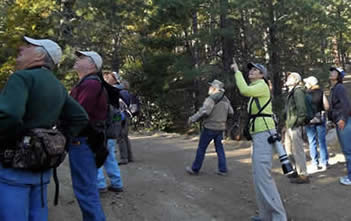 |
Red-breasted Nuthatch – Photo/ Muriel Neddermeyer |
Photo/Doug Jenness |
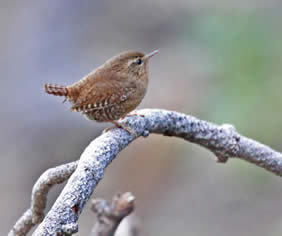 |
Pacific Wren - Photo/Muriel Neddermeyer |
As luck would have it, the highlight of the morning, a RED-BREASTED SAPSUCKER, flew in while the group was parked at the entrance to the park! It was skittish and flighty, but most participants were able to see the characteristic bright red head and breast. With flyover Band-tailed Pigeons and Evening Grosbeaks also seen by some members of the
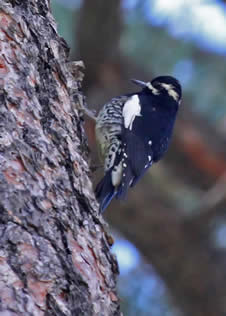 |
Williamson’s Sapsucker – Photo/ Muriel Neddermeyer |
group, the park entrance may have been the best birding spot of the day! Still, the group continued on to the trailhead and spent the next several hours hiking about 1.5 miles through Ponderosa Pine, Douglas-Fir, White Fir, and high elevation riparian forest. Finch sightings continued, with flyover Pine Siskins heard throughout the day and a flock of Cassin’s Finches near the trailhead. Surprisingly, Red-breasted Nuthatch numbers were about normal for the area, having dropped significantly from the flocks present a few weeks before. A calling Pacific Wren caused excitement, but everyone was truly surprised when it was joined by a second individual! Despite calling incessantly, it gave only brief looks at first, but eventually perched out in the open for the entire group to study (and photograph). The participants discussed differences in plumage and call types between this and the closely related Winter Wren. A single Townsend’s Solitaire was a nice treat, but was quickly abandoned when a male Williamson’s Sapsucker appeared. After skulking in the treetops, the striking woodpecker eventually settled on the side of a large Ponderosa and allowed the group to study and photograph it.
We enjoyed a lunch break on a rock outcropping overlooking the forest and the city of Kingman. While keeping an ear out for passing birds, observers discussed the plants and animals seen that day, oddities such as the scarcity of chickadees, and speculated about breeding birds. After lunch, a slow hike down the road brought the group back to the trailhead and to the end of the meeting. Participants agreed that the perfect weather and great birding, together with the expertise of so many knowledgeable participants, made for a wonderful morning in these unique and under-explored mountains.





